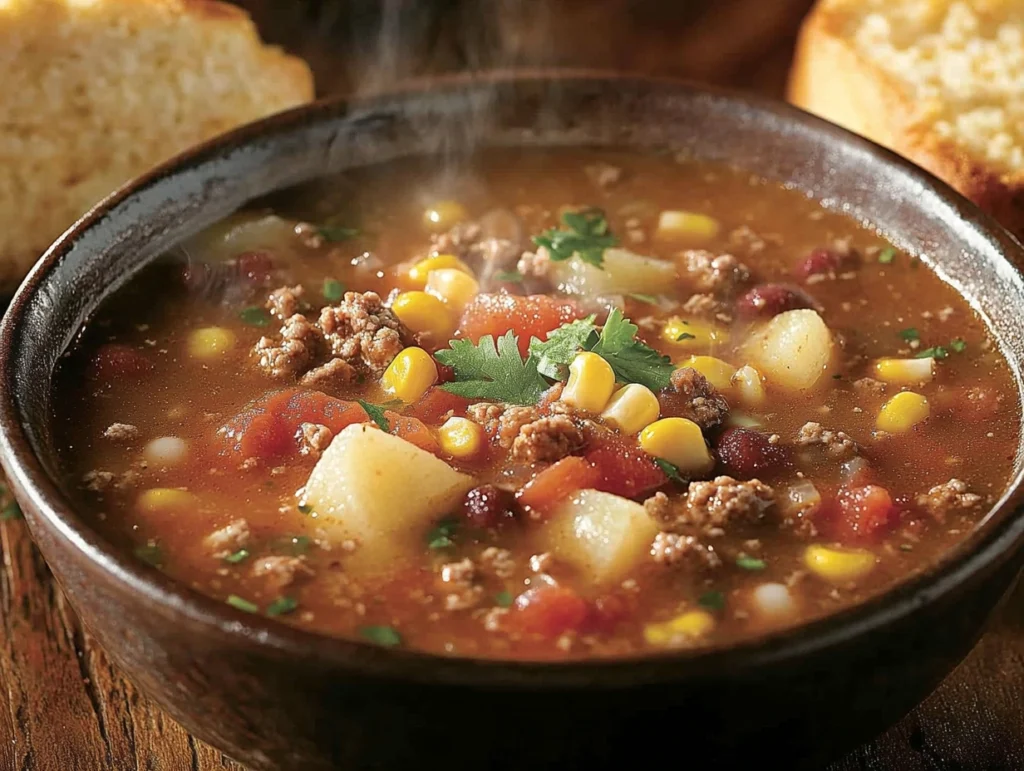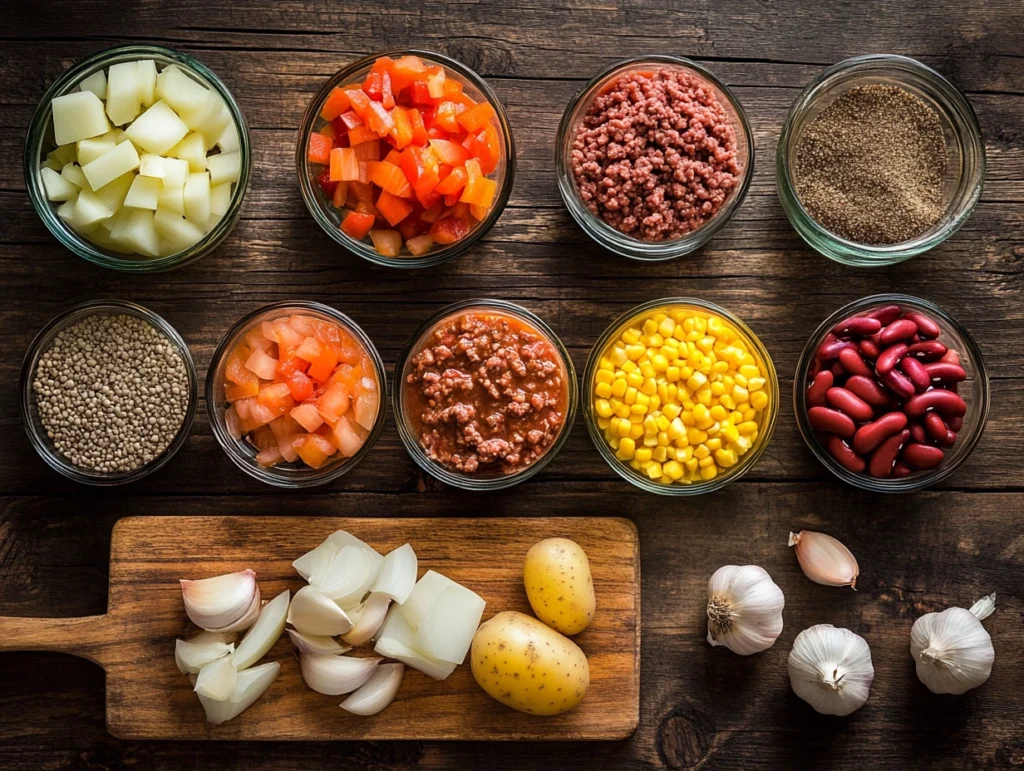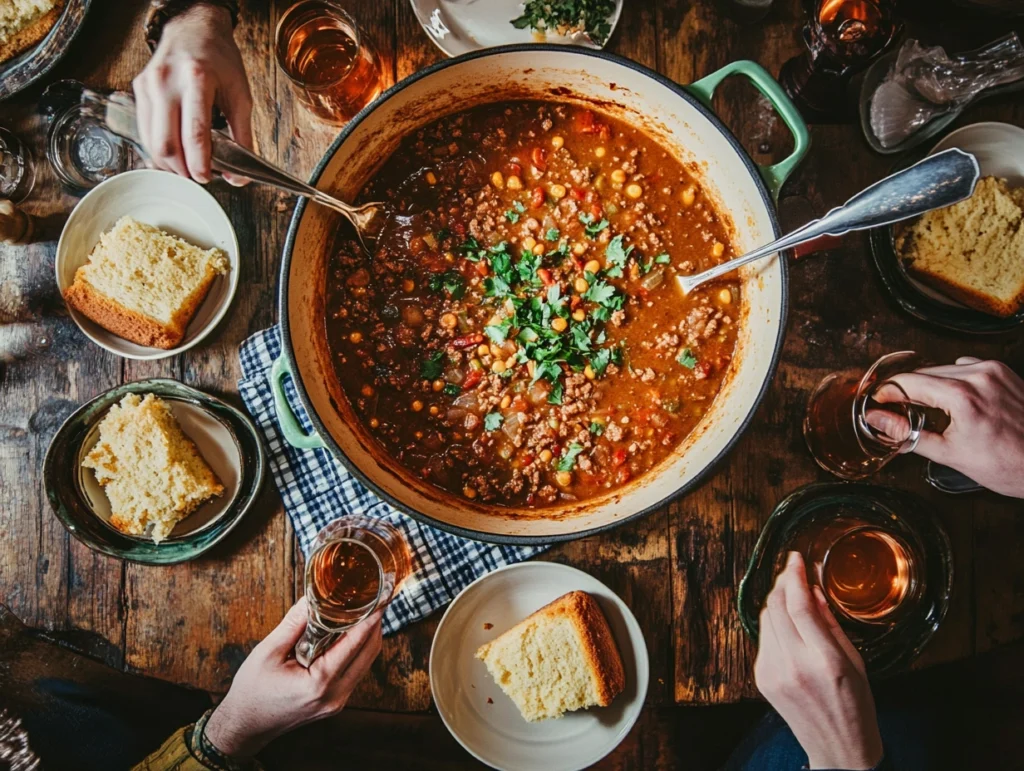1. Introduction
When it comes to comfort food, few dishes can rival the warmth and richness of cowboy soup. This hearty dish is a timeless classic, combining robust flavors and a rustic charm that appeals to all ages. Cowboy soup has long been a staple of American cuisine, with roots deeply embedded in the traditions of the Wild West. Whether it’s enjoyed on a chilly evening or served at a summer cookout, this soup offers a perfect blend of nostalgia and satisfaction.

Alt Text: A bowl of hearty cowboy soup with beef, beans, tomatoes, and potatoes, garnished with cilantro and cheese, served with cornbread.
Cowboy soup is more than just a recipe—it’s a reflection of a time when food needed to be simple, nourishing, and easy to prepare. Originating during the cattle drives of the 19th century, this dish has evolved from a survival meal for hardworking cowboys into a beloved comfort food across the United States.
In this article, we’ll dive deep into what makes cowboy soup so special, explore its history, and provide a step-by-step guide to creating your own bowl of this hearty delight.
2. What Is Cowboy Soup Made Of?
The magic of cowboy soup lies in its simplicity and versatility. Traditionally, this dish uses accessible, everyday ingredients that can be adapted to suit a variety of tastes and dietary preferences. Here’s a closer look at the core ingredients that form the base of this iconic dish:
Core Ingredients
- Ground Beef
- A rich and savory protein, ground beef forms the foundation of cowboy soup. Its bold flavor adds depth and pairs beautifully with the other ingredients.
- Onions and Garlic
- These aromatic staples enhance the soup’s flavor profile, adding both sweetness and spice.
- Beef Broth
- A flavorful liquid base that binds the ingredients together while providing a robust and hearty taste.
- Beans
- Pinto beans and kidney beans are common choices, adding texture and a good dose of protein and fiber.
- Tomatoes and Green Chilies
- The combination of diced tomatoes and chilies offers a tangy, slightly spicy kick that balances the soup’s richness.
- Potatoes
- These starchy additions bring creaminess and substance, making the soup more filling.
- Corn and Mixed Vegetables
- These bring bursts of sweetness and color, enhancing the soup’s visual appeal and nutritional value.
- Spices
- Chili powder, cumin, salt, and black pepper are the essential seasonings, giving the soup its signature Southwestern flair.
Regional and Personal Variations
- Vegetarian Options
- Replace ground beef with plant-based meat or beans like black beans or chickpeas.
- Spice Adjustments
- For those who prefer a milder taste, green bell peppers can be used in place of chilies.
- Broth Customization
- Swap beef broth with vegetable broth for a lighter, vegetarian-friendly version.
This diverse ingredient list not only reflects the rustic charm of cowboy soup but also highlights its adaptability. Whether you stick to the traditional recipe or give it your own twist, the essence of cowboy soup lies in its hearty, no-fuss preparation.
3. The History and Origins of Cowboy Soup
Cowboy soup is deeply rooted in the history of the American West, a time when cattle drives and open prairies defined the frontier lifestyle. During the 19th century, cowboys embarked on long journeys herding cattle across vast landscapes. With limited resources and the need for sustenance, they relied on meals that were simple to prepare, filling, and made with non-perishable ingredients.
Influence of the Chuckwagon Era
The chuckwagon, a mobile kitchen wagon used during cattle drives, played a significant role in shaping cowboy cuisine. Meals were often prepared in large pots over an open flame, and the ingredients had to be practical and easy to store. Staples like beans, canned tomatoes, dried chilies, and cured meats became the foundation of cowboy soup.
Evolution of the Dish
Originally, cowboy soup may have been an adaptation of frijoles charros, a traditional Mexican bean stew, combined with elements of “sonofabitch stew,” a frontier-era dish that used various cuts of beef. Over time, the recipe evolved into the hearty and customizable soup we know today, reflecting the multicultural influences of the American Southwest.
From Survival to Comfort Food
As cowboys transitioned from the trails to more settled lives, cowboy soup became a nostalgic dish, symbolizing the rugged yet romanticized spirit of the Old West. Today, it is celebrated for its versatility, simplicity, and ability to bring people together around the table.
4. Nutritional Value of Cowboy Soup
Cowboy soup isn’t just flavorful—it’s also packed with nutrients, making it a balanced meal option for any occasion. Here’s a closer look at the health benefits of its key ingredients:
Macronutrient Breakdown
- Proteins: Ground beef and beans are excellent sources of protein, essential for muscle repair and overall health.
- Carbohydrates: Potatoes, corn, and beans provide a steady source of energy, making the soup a satisfying main course.
- Fats: While ground beef contains fats, using lean cuts can reduce saturated fat content. Healthy fats can also be added by topping the soup with avocado slices.
Vitamins and Minerals
- Vitamin C: Tomatoes, chilies, and corn contribute significant amounts of Vitamin C, which supports the immune system.
- Iron: The beef and beans in cowboy soup are rich in iron, a critical mineral for preventing anemia.
- Fiber: Beans and vegetables provide dietary fiber, aiding digestion and promoting gut health.
Health Benefits of Cowboy Soup
- Balanced Nutrition: With protein, fiber, and essential vitamins, cowboy soup is a one-pot meal that meets various dietary needs.
- Heart Health: By choosing lean beef and reducing salt, cowboy soup can be adapted for heart-conscious eaters.
- Energy-Boosting: The combination of carbohydrates and proteins makes it a perfect choice for sustaining energy levels throughout the day.
While cowboy soup is inherently nutritious, it can be tailored further to suit specific dietary preferences, making it a versatile option for all.
5. How to Make Cowboy Soup from Scratch
Making cowboy soup at home is straightforward and rewarding. This recipe combines traditional techniques with a modern twist, ensuring you achieve the perfect balance of flavor, texture, and heartiness.

Alt Text: A bowl of hearty cowboy soup with beef, beans, tomatoes, and potatoes, garnished with cilantro and cheese, served with cornbread.
5.1. Ingredients List
To make a pot of cowboy soup, you’ll need:
- 1 lb ground beef (or substitute with ground turkey or plant-based meat for a vegetarian version)
- 1 medium onion, diced
- 2 cloves garlic, minced
- 4 cups beef broth (or vegetable broth for a lighter option)
- 1 can (15 oz) pinto beans, drained and rinsed
- 1 can (15 oz) kidney beans, drained and rinsed
- 1 can (15 oz) diced tomatoes
- 1 can (10 oz) diced green chilies
- 2 large potatoes, peeled and cubed
- 1 cup frozen corn
- 1 cup mixed vegetables (optional)
- 2 tsp chili powder
- 1 tsp cumin
- Salt and black pepper to taste
- Optional toppings: shredded cheese, chopped cilantro, sour cream, or crushed tortilla chips
5.2. Step-by-Step Cooking Instructions
- Brown the Ground Beef:
In a large pot or Dutch oven, cook the ground beef over medium heat until browned. Break it apart with a wooden spoon as it cooks. Drain excess fat and set aside. - Sauté Aromatics:
Add the diced onion and minced garlic to the pot. Sauté for 2-3 minutes, stirring frequently, until the onions become translucent and fragrant. - Combine the Base Ingredients:
Return the ground beef to the pot. Add the beef broth, diced tomatoes, and green chilies. Stir to combine. - Incorporate Beans and Vegetables:
Stir in the pinto beans, kidney beans, cubed potatoes, and mixed vegetables (if using). - Season and Simmer:
Add chili powder, cumin, salt, and pepper. Bring the soup to a gentle boil, then reduce the heat to low. Cover and simmer for 20-25 minutes, or until the potatoes are tender. - Add Corn and Final Touches:
Stir in the corn and cook for an additional 5 minutes. Adjust seasoning as needed. - Serve and Enjoy:
Ladle the soup into bowls and add your favorite toppings, such as shredded cheese, sour cream, or fresh cilantro. Serve with warm cornbread or tortilla chips on the side.
6. Variations of Cowboy Soup
Cowboy soup is celebrated for its adaptability. Here are some creative variations to suit different tastes and dietary preferences:
6.1. Vegetarian and Vegan Options
- Replace ground beef with plant-based proteins like lentils, black beans, or crumbled tofu.
- Use vegetable broth instead of beef broth to create a fully vegan version.
- Add extra vegetables like zucchini, bell peppers, or mushrooms for enhanced flavor and texture.
6.2. Regional Twists
- Tex-Mex Style:
Incorporate spices like smoked paprika and cayenne, and top with diced avocado and lime juice. - Southern-Style:
Add okra, collard greens, and ham for a comforting Southern twist.
6.3. International Versions
- Mexican Influence:
Serve with warm tortillas and a dollop of crema for a nod to Mexican cuisine. - Hungarian Inspiration:
Incorporate smoked sausage and sweet paprika for a gulyásleves-inspired version.
These variations showcase the versatility of cowboy soup, allowing you to experiment with flavors and ingredients to suit any palate.
7. Serving Suggestions
Cowboy soup is a meal in itself, but pairing it with complementary sides and garnishes can elevate the dining experience. Here are some ideas to make your cowboy soup unforgettable.

Alt Text: A large pot of cowboy soup served at a rustic table with friends and family enjoying bowls of the hearty dish.
7.1. Ideal Accompaniments
- Cornbread:
Warm, buttery cornbread is a classic side that complements the hearty flavors of cowboy soup. Opt for a slightly sweet version to balance the soup’s savory elements. - Tortilla Chips:
Crispy tortilla chips add texture and can be used for dipping or as a crunchy topping. - Bread Rolls:
Soft, warm bread rolls are perfect for soaking up the flavorful broth.
7.2. Beverage Pairings
- Iced Tea:
A refreshing glass of iced tea, sweetened or unsweetened, pairs beautifully with the rich and spicy notes of the soup. - Beer:
For adult gatherings, a light lager or a robust stout enhances the dish’s rustic charm. - Sparkling Water with Citrus:
A fizzy, citrus-infused water offers a refreshing counterpoint to the soup’s hearty flavors.
7.3. Garnishing Ideas
- Shredded cheese (cheddar or Monterey Jack)
- Fresh cilantro or parsley
- A dollop of sour cream or Greek yogurt
- Crumbled bacon for an extra savory touch
- A drizzle of hot sauce for spice lovers
These serving suggestions ensure that cowboy soup remains the star of the table while offering a variety of textures and flavors to enhance the meal.
8. Storing and Reheating Cowboy Soup
Cowboy soup is a fantastic make-ahead meal. It stores well and often tastes even better the next day as the flavors meld. Here’s how to store and reheat it properly:
8.1. Refrigeration Guidelines
- Allow the soup to cool to room temperature before storing.
- Transfer it to an airtight container and refrigerate for up to 3-4 days.
- Avoid leaving the soup at room temperature for more than two hours to prevent spoilage.
8.2. Freezing Instructions
- Cowboy soup freezes exceptionally well. Pour it into freezer-safe containers or heavy-duty resealable bags, leaving some space for expansion.
- Label the containers with the date, and freeze for up to 3 months.
- To thaw, move the container to the refrigerator the night before reheating.
8.3. Best Practices for Reheating
- On the Stovetop:
Pour the soup into a pot and reheat over medium heat, stirring occasionally, until warmed through. Add a splash of water or broth if the soup has thickened too much. - In the Microwave:
Transfer a portion to a microwave-safe bowl. Cover with a vented lid or plastic wrap and heat in 1-minute intervals, stirring between each.
Proper storage and reheating techniques ensure that your cowboy soup remains delicious and safe to enjoy, even as leftovers.
9. Health Considerations
Cowboy soup is a hearty and nutritious dish, but like any meal, it can be tailored to fit specific dietary needs and health goals. Here are some health considerations and tips for making cowboy soup a guilt-free delight.
9.1. Managing Sodium Content
- Why it matters:
Many of the soup’s ingredients, such as canned beans, tomatoes, and broth, can be high in sodium. - Solutions:
- Opt for low-sodium or no-salt-added canned goods and broth.
- Season with herbs and spices like smoked paprika, garlic powder, and black pepper instead of relying solely on salt.
9.2. Adjusting for Dietary Restrictions
- Gluten-Free Options:
Cowboy soup is naturally gluten-free if you ensure that your broth and canned ingredients are free from added gluten. - Low-Carb Alternatives:
Swap out potatoes for diced zucchini or cauliflower florets to reduce the carbohydrate content. - Dairy-Free Adaptations:
Simply skip the cheese and sour cream toppings, or use dairy-free alternatives to maintain a creamy texture.
9.3. Incorporating Fresh, Organic Ingredients
- Using fresh vegetables and grass-fed beef enhances the soup’s nutritional profile while supporting sustainable farming practices.
- Organic options can also reduce exposure to pesticides and artificial additives.
By keeping these tips in mind, you can enjoy cowboy soup in a way that aligns with your health and lifestyle goals without compromising on flavor.
10. Cowboy Soup in Popular Culture
The charm of cowboy soup goes beyond the dining table. Its rich history and rustic appeal have made it a cultural icon, often featured in media and celebrated in Western folklore.
10.1. Appearances in Media
- Cowboy soup is frequently mentioned in movies, TV shows, and books that celebrate the spirit of the Wild West. It symbolizes resilience, community, and the rugged lifestyle of cowboys.
- In cooking competitions and food documentaries, cowboy soup often stands out as a nostalgic and flavorful representation of frontier cuisine.
10.2. Associations with Western Folklore
- Cowboy soup is more than just a dish; it’s a reminder of the camaraderie around the chuckwagon during long cattle drives.
- The dish is celebrated at rodeos, country fairs, and cowboy-themed events as a nod to America’s pioneering past.
10.3. Modern-Day Popularity
- Today, cowboy soup has found its place in cookbooks, food blogs, and home kitchens across the country.
- Its versatility and simplicity make it a favorite among busy families, meal preppers, and anyone seeking a comforting, crowd-pleasing dish.
Whether enjoyed in a cozy home or at a Western-themed gathering, cowboy soup continues to capture the hearts and taste buds of people everywhere.
11. Frequently Asked Questions (FAQs)
In this section, we answer common questions about cowboy soup and related culinary topics. These FAQs address everything from ingredients to global soup comparisons.
11.1. What is Cowboy Soup Made Of?
Cowboy soup is made with a combination of ground beef, onions, garlic, beans, tomatoes, chilies, potatoes, corn, and flavorful spices such as chili powder and cumin. These ingredients blend to create a hearty, well-balanced meal that is rich in flavor and nutrients. For a detailed ingredient list and variations, refer to Section 2 of this article.
11.2. What is the Most Delicious Soup in the World?
While the “most delicious soup” is subjective and varies by personal taste, cowboy soup ranks high for its comforting flavors and adaptability. Other contenders include:
- Pho (Vietnam): A fragrant noodle soup with beef or chicken, flavored with aromatic spices.
- Tom Yum (Thailand): A spicy and sour soup known for its bold flavors.
- Bouillabaisse (France): A seafood stew with a rich, saffron-infused broth.
- Minestrone (Italy): A vegetable-packed soup, often featuring pasta or rice.
11.3. What Are the Four Thick Soups?
Thick soups are categorized based on their texture and ingredients. Here are four common types:
- Chowder: A creamy, chunky soup often made with seafood, potatoes, and milk or cream.
- Bisque: A smooth, pureed soup, typically made with shellfish like lobster or shrimp.
- Purée: Thickened by blending vegetables, such as in tomato or lentil soup.
- Cream Soup: Made by adding cream or béchamel sauce to the base, such as cream of mushroom or broccoli soup.
11.4. What is Nsala Soup Made Of?
Nsala soup, also known as white soup, is a traditional Nigerian dish. It is made with fresh fish, goat meat, or chicken, thickened with yam or yam powder. Key spices include utazi leaves, crayfish, and African nutmeg, giving it a unique flavor profile. While distinct from cowboy soup, it shares the common thread of being a hearty and culturally significant dish.
12. Conclusion
Cowboy soup is more than just a meal; it’s a story told through its ingredients and history. Born from the need for sustenance on the rugged trails of the Wild West, this dish has evolved into a beloved staple of American comfort food. Its versatility allows for endless creativity, whether you prefer a traditional recipe or a modern twist.
The beauty of cowboy soup lies in its ability to bring people together. Whether you’re enjoying it at a family dinner, serving it at a gathering, or savoring a bowl on a quiet evening, cowboy soup offers warmth, nourishment, and a touch of nostalgia.
Now that you have everything you need to know—from its history and nutritional value to preparation tips and serving suggestions—it’s time to get cooking. Try this recipe, make it your own, and share the joy of cowboy soup with friends and family.
